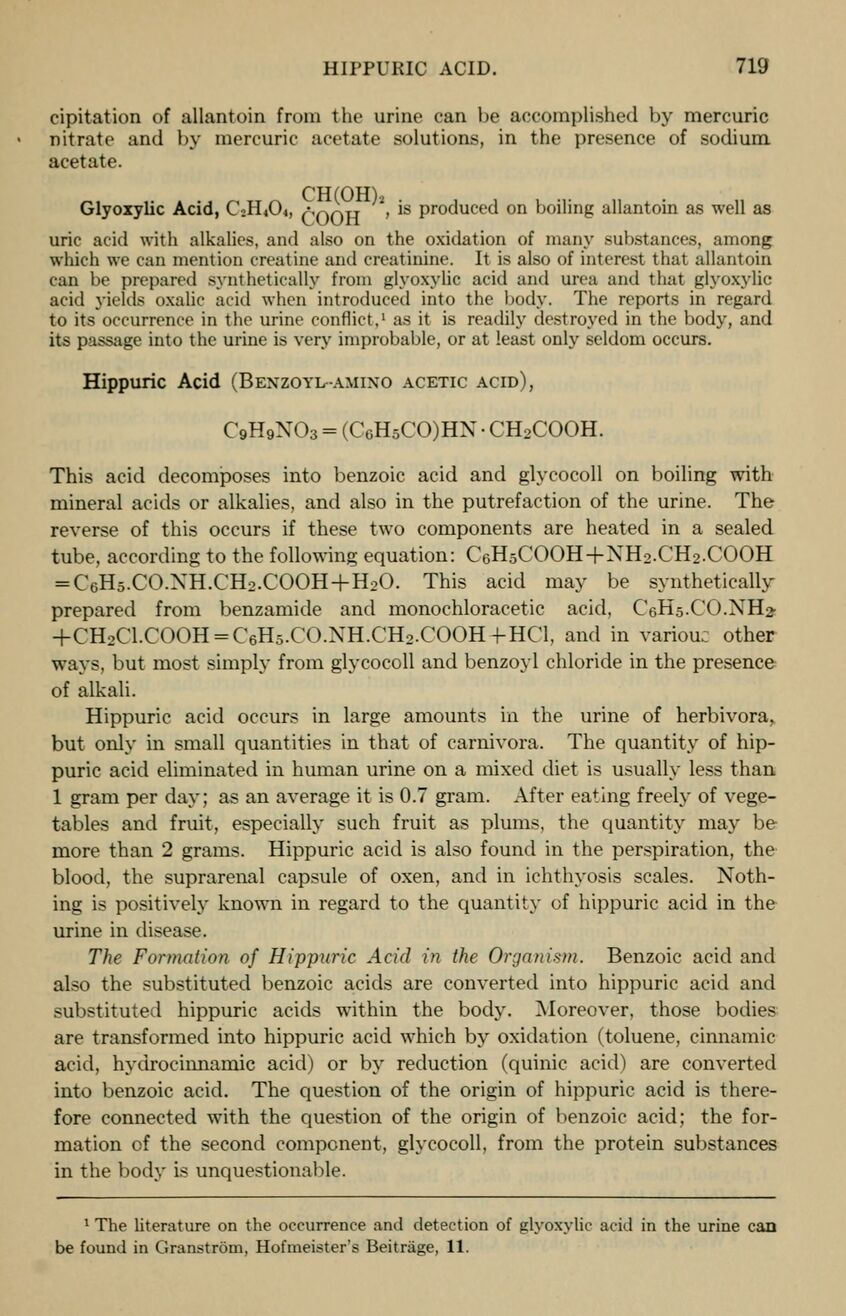
Full resolution (JPEG) - On this page / på denna sida - XIV. Urine - II. Organic Physiological Constituents of Urine

<< prev. page << föreg. sida << >> nästa sida >> next page >>
Below is the raw OCR text
from the above scanned image.
Do you see an error? Proofread the page now!
Här nedan syns maskintolkade texten från faksimilbilden ovan.
Ser du något fel? Korrekturläs sidan nu!
This page has never been proofread. / Denna sida har aldrig korrekturlästs.
HIPPUKIC ACID. 719
cipitation of allantoin from the urine can be accomplished by mercuric
nitrate and by mercuric acetate solutions, in the presence of sodium
acetate.
Glyoxylic Acid, C;H404, /v^tt ,
is produced on boiling allantoin as well as
uric acid with alkalies, and also on the oxidation of many substances, among
which we can mention creatine and creatinine. It is also of interest that allantoin
can be prepared synthetically from glyoxylic acid and urea and that glyoxylic
acid yields oxalic acid when introduced into the body. The reports in regard
to its occurrence in the urine conflict, 1
as it is readily destroyed in the body, and
its passage into the urine is very improbable, or at least only seldom occurs.
Hippuric Acid (Benzoyl amino acetic acid),
C9H9XO3 = (C6H5CO)HN •
CH2COOH.
This acid decomposes into benzoic acid and glycocoll on boiling with
mineral acids or alkalies, and also in the putrefaction of the urine. The
reverse of this occurs if these two components are heated in a sealed
tube, according to the following equation: C6H5COOH +XH2.CH2.COOH
= C6H5 .CO.XH.CHo.COOH+H2 0. This acid may be synthetically
prepared from benzamide and monochloracetic acid, CeH5.CO.NHa
+CH2 Cl.COOH = C6H5.CO.NH.CH2 .COOH-r-HCl, and in variou: other
ways, but most simply from glycocoll and benzoyl chloride in the presence
of alkali.
Hippuric acid occurs in large amounts in the urine of herbivora,
but only in small quantities in that of carnivora. The quantity of hip-
puric acid eliminated in human urine on a mixed diet is usually less than
1 gram per day; as an average it is 0.7 gram. After eating freely of vege-
tables and fruit, especially such fruit as plums, the quantity may be
more than 2 grams. Hippuric acid is also found in the perspiration, the
blood, the suprarenal capsule of oxen, and in ichthyosis scales. Noth-
ing is positively known in regard to the quantity of hippuric acid in the
urine in disease.
The Formation of Hippuric Acid in the Organism. Benzoic acid and
also the substituted benzoic acids are converted into hippuric acid and
substituted hippuric acids within the body. Moreover, those bodies
are transformed into hippuric acid which by oxidation (toluene, cinnamic
acid, hydrocinnamic acid) or by reduction (quinic acid) are converted
into benzoic acid. The question of the origin of hippuric acid is there-
fore connected with the question of the origin of benzoic acid; the for-
mation of the second component, glycocoll, from the protein substances
in the body is unquestionable.
1
The literature on the occurrence and detection of glyoxylic acid in the urine can
be found in Granstrom, Hofmeister"s Beitrage, 11.
<< prev. page << föreg. sida << >> nästa sida >> next page >>